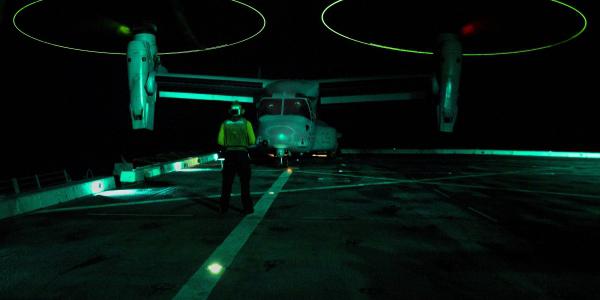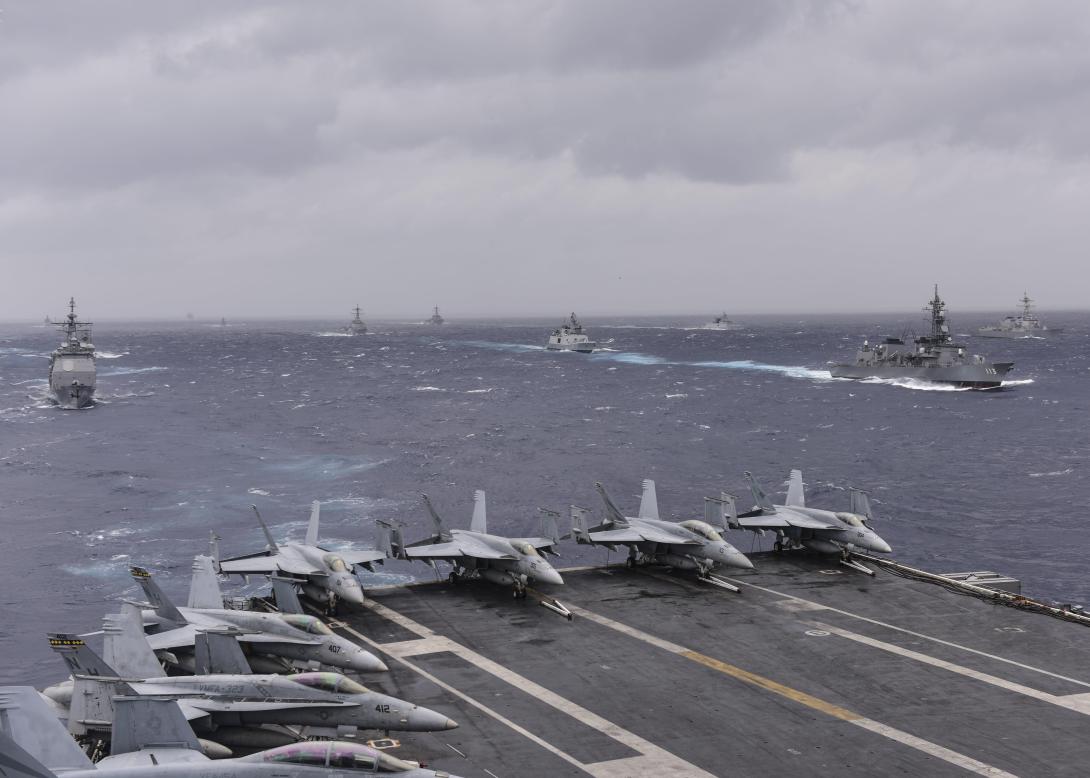Innovation, Partners Fortify Pacific Fleet
The U.S. Pacific Fleet is focusing on improving personnel capabilities and increasing interoperability with other nations to carry out its mission amid changes and growing threats. With no indication that it will receive more resources now or in the near future, the Pacific Fleet is innovating and adding external partnerships to its arsenal of proficiencies for being proactive rather than reactive to events in the Indo-Asia-Pacific region.
China remains the biggest challenge facing the Pacific Fleet (PACFLT), states Adm. Scott Swift, USN, PACFLT commander. While many experts suggest that war between the United States and China is inevitable, Adm. Swift says he does not believe it is a foregone conclusion. However, he notes that U.S. friends and allies in the area all believe that China’s emergence as a global economic and military power must be accommodated. And PACFLT must pursue mechanisms to achieve that goal, he says.
Other challenges have not disappeared. Piracy is still a problem, and Russia is rising again as a factor in the region. North Korea ratchets up tensions as it moves forward with nuclear weapon and missile development. And environmental issues, including events that require humanitarian aid and recovery assistance, can pop up as quickly as the weather changes.
At the core of meeting these challenges is personnel. More duties have not led to more people, Adm. Swift notes. The PACFLT staff has not grown since the early 1990s, and the intervening period includes the 9/11 attacks and the wars in Southwest Asia. With nearly two-thirds of the Navy assigned to PACFLT, the absence of an increase in personnel—civilian as well as military—presents its own kind of challenge.
The admiral emphasizes that he does not lack the ships necessary to carry out his expanding mission. He is focusing on developing tactics, techniques and procedures as well as strategies to do so. “We need to face those challenges with the resources that we have,” he says. This approach is impelled in part by the budgeting uncertainties that have plagued all the services for several years. “It’s hard to make these plans when you don’t have at least a sense of what next year’s budget is going to be, much less getting to a five-year budget,” he points out.
“My responsibility is to utilize the forces I have and [shape] operations based on those forces,” Adm. Swift adds. “We have been very richly resourced over the past 15 years by the American taxpayer, especially with respect to the challenges we have faced in the Middle East.”
What concerns him are cuts to PACFLT resources, especially in personnel. While people can be redistributed across the force, the admiral opposes proposals to reduce Navy personnel.
He places people at the top of his resource wish list, and he wants either quantity or quality. He says PACFLT is blessed with high-quality personnel who enable increased capabilities with their skills—for example, setting up secure communications using commercial gear. But PACFLT must continue to fuel the personnel pipeline by recruiting people with the intellectual curiosity necessary to stay ahead of the problems the fleet faces.
“We stay ahead of challenges in the region by energizing the most critical weapon system that we have: the one that resides between the ears of every sailor who reports for duty every day,” Adm. Swift declares.
The environment in which PACFLT operates is changing constantly, he points out, and the fleet must change accordingly. However, that pace of change has picked up, and its direction has become more diverse. PACFLT must meet these changes operationally as well as in planning and in personnel. Technology is both a driver of these challenges wrought by change and a remedy for them. “We need to work hard to make sure we’re at least pacing that change … if not staying ahead of the change and being predictive of where it is going,” he says.
This change is so broad that the admiral eschews any list of top priorities. Virtually all aspects of PACFLT are affected and must be adjusted if it is to accomplish its mission.
He cites the 3rd Fleet Forward initiative, which launched with the arrival of its new commander, Vice Adm. Nora Tyson, USN, as an example of the approach PACFLT is taking. Traditionally, 3rd Fleet ships came under the command of the 7th Fleet whenever they crossed the international date line. Both fleets are part of PACFLT, and under the new initiative, they retain their separate commands and identities.
For personnel, the key PACFLT initiative is known as The Bridge. Adm. Swift explains that it creates opportunities for all 140,000 sailors in the Pacific to bring innovative ideas forward. It is designed to advance education, enable empowerment, stimulate connections and spur transition as a bridge between imagination and reality. Adm. Swift notes that sailors’ suggestions are reviewed at every quarterly commanders conference, where a number are chosen to be mainstreamed into PACFLT.
One example concerns a sailor who came up with a way of calculating the ideal speed for rotors on a helicopter when it is sitting on a ship’s fantail. This method accounts for ship speed, sea state, wind speed and ship direction to avoid losing the helicopter over the side. The sailor invented a circular slide rule that sets parameters constituting an acceptable risk range for the helicopter’s rotors. In working with the Office of Naval Research to develop this calculator, PACFLT discovered that patenting an invention could provide a sailor with royalty payments instead of a single bonus check, so it is exploring that possibility for future Bridge innovations.
Making better use of resources includes interoperating with regional allies and partners, and PACFLT has its own efforts to improve that interoperability. Adm. Swift says PACFLT is working to improve interoperability among treaty nations. Three members of the Five Eyes intelligence alliance—Australia, Canada and New Zealand—are Pacific nations, along with the United States, and that alliance permits considerable leeway in improving interoperability.
But Japan, for example, is not a Five Eyes partner, and interoperability must proceed along more complicated lines. “The challenge becomes how do we generate a bilateral relationship and then expand that into a multilateral relationship, especially in the context of information sharing,” Adm. Swift points out.
With North Korea a common threat to many nations, the United States, Japan and South Korea have significant capability to counter it, the admiral states. But to optimize that capability, they need to network their sensors and information flow so they do not waste weapons on a single target, such as a North Korean missile, which all three nations can intercept.
Even trilateral information sharing among the three allied nations can—and should—be advanced to more of a multilateral context involving other nations, Adm. Swift says. Other nations can be brought into a more interoperable relationship to improve their ability to operate together.
Adm. Swift cites India as a prime candidate. Having been to India several times, he has built close relationships with past and present Indian naval leaders. India poses unique technical interoperability challenges: For example, it bought the U.S.-built P-8I airframe but installed an indigenous weapon system the United States does not know well. Interoperating with this system is a challenge PACFLT is embracing, he says.
The recently completed Malabar 2017 exercise, which included U.S., Indian and Japanese forces, focused on interoperability among systems produced independently of each other. The exercise aimed to share information seamlessly among the three forces to the same degree that PACFLT units share information among themselves, he says.
Adm. Swift compares Indo-Asia-Pacific interoperability challenges to those faced by emergency responders during 9/11. Units that needed to communicate across organizational lines found themselves unable to do so at the worst moment of the crisis. Similar conditions exist today among allies, partners and friends, especially as individual nations modernize systems independent of each other. PACFLT is working to ameliorate these problems before a crisis hits.
To help improve interoperability with nontreaty nations, PACFLT engages in bilateral exercises with nations such as Indonesia and Malaysia. A growing initiative among these two nations and the Philippines over the last year seeks to increase security in their region, and the United States has supported their efforts to improve information interoperability.
This initiative is especially sensitive because the three countries do not completely agree on the precise locations of their borders, Adm. Swift notes. Its success could help bring together three neighbors that face common concerns, including terrorist attacks such as the one in Marawi City, Philippines. PACFLT has supported all three nations militarily with increased patrols that share information with any of the three countries, he relates.
Other PACFLT operations work to combat piracy. Malaysia, Indonesia, Singapore and Thailand are part of PACFLT efforts in the Strait of Malacca. The four nations contributed their own aircraft and ships in this effort, the admiral reports.
Achieving interoperability with other nations involves both technology and relationship building. Part of the problem in meeting technical challenges can be found in U.S. acquisition regulations. Rather than trying to change them, PACFLT is working around the limitations within the law, Adm Swift says.
Regulations place a barrier between government and industry to avoid providing an unfair advantage to one company over others, he notes. Access to government intellectual property must be shared broadly, but individual companies are reluctant to offer new technologies under existing rules.
PACFLT is finding creative ways to fill gaps in technology. The fleet established a Sea of Dreams conference at the Secret level last fall in which more than 100 companies participated. At the first of what leaders hope will be an annual event, PACFLT described the challenges it faces over the vast region and then asked industry to examine how it could solve them. Adm. Swift lauds the dialogue it spawned for bringing industry’s capabilities into the military.






Comments